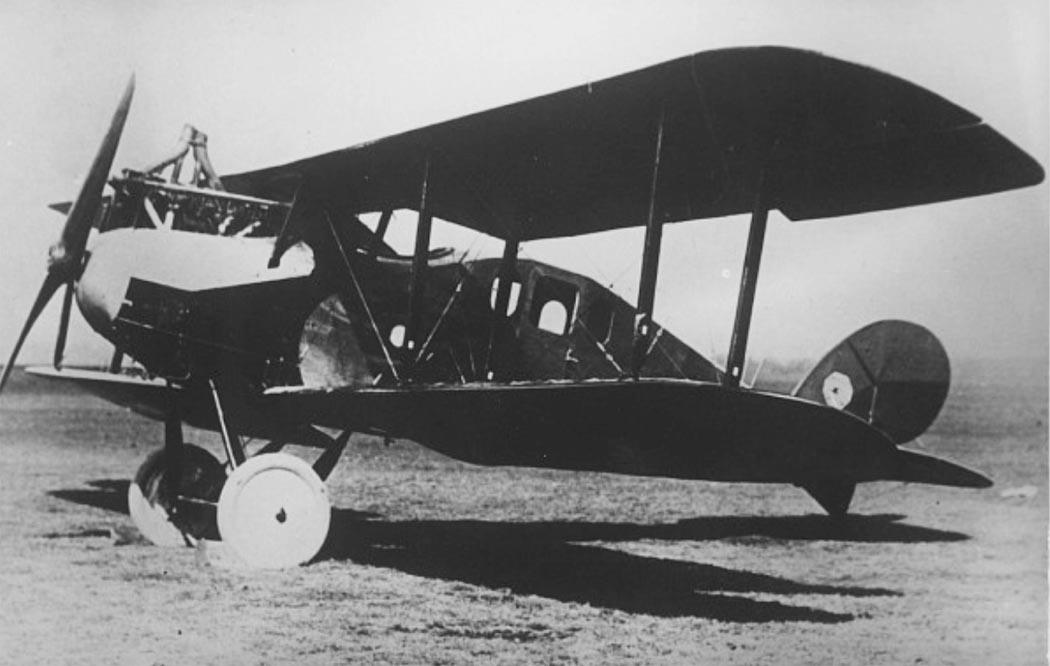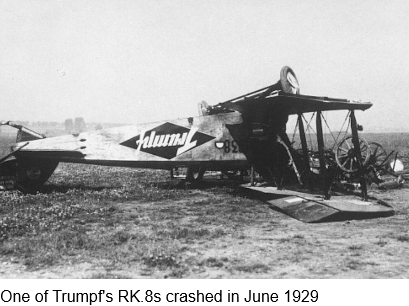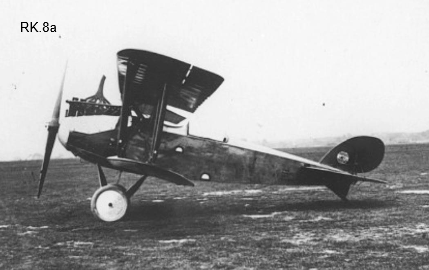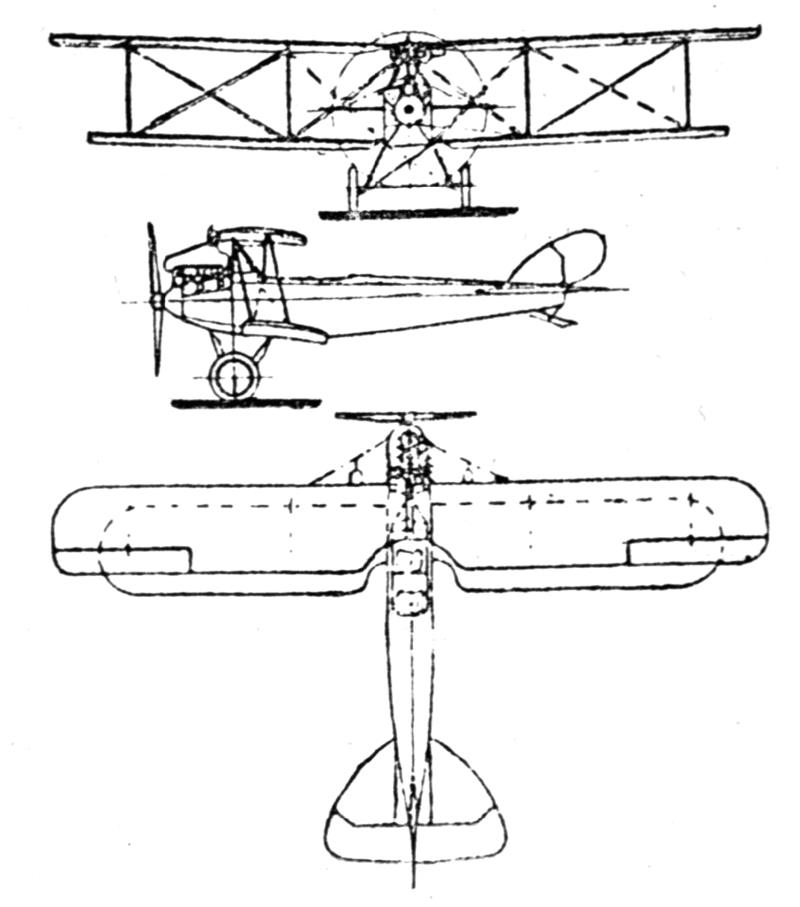| Type |
RK 8 closed cabin |
RK 8a open cabin photo and spraying aircraft |
| Engine |
1 Benz Bz 4 or Junkers L 2 |
1 Benz Bz 4 or Junkers L 2 |
| Dimensions |
Length 7,50 m , height 2,90 m , span upper 13,0 m lower 12,48 m , wing area 36,0 m2 , |
| Weights |
Empty 1020 kg , loaded 1500 kg , max. take off weight |
Empty 960 kg , loaded 1400 kg , max. take off weight |
| Performance |
Max.. speed 160 km/h , cruising speed , range 400 km, endurance , service ceiling 4000 m , climb |
Max.. speed 155 km/h , cruising speed , range 400 km, endurance , service ceiling 4000 m , climb
|
| Type |
Werk.Nr |
Registration |
History |
|
40 |
D-1114 |
Raka, Kassel. Not in use after March 1932 |
|
41 |
D-1216 |
LV Ges, Hamburg. Destroyed June 1929 |
|
|
|
Trumpf Schokolade-Werke |
|
|
|
Trumpf Schokolade-Werke |
|
|
|
To Hungary , used with light advertising |
|
|
|
To Hungary , used with light advertising |
|
|
|
Spraying aircraft |
|
|
|
Spraying aircraft |
|
|
|
|
|
|
|
|




In 1929, Raab-Katzenstein-Flugzeugwerke GmbH began converting another reconnaissance aircraft from the First World War into a civilian aircraft. This time we chose a slightly larger car - LVG C.VI. Instead of an open observer's cabin, a closed cabin for three passengers was installed. In this form, the aircraft received the designation Raab-Katzenstein RK.8 Marabu.
Initially, a used Benz Bz.IV was bought for 2500 Reichsmarks for RK.8 (as in the base aircraft), but then the engines were replaced with a more advanced Junkers L 2 six-cylinder water-cooled engine of the same power.
In 1929, two RK.8s were built specifically for the Trumpf chocolate company. They were used mainly for nighttime advertising. Two more machines for similar purposes were purchased by industrialists from Hungary.
Another aircraft was made with an open second cockpit and received the designation RK.8a. In the early 1930s, the RK.8a was used to fight forest fires near Kassel.
Source: Aerokurier 1970
RK 8 Marabu (LVG C-Vl)
This aircraft was again a licensed version of the LVG C-Vl military aircraft. It was built especially as a photo aircraft and later as a training aircraft because various aerial photography companies needed such an aircraft at the time. One aircraft went to Mannheim, another to Coburg. Another Marabu was built for a parachutist who used this aircraft to perform double jumps with his wife. A special version of the Marabu even had a cabin for three people to operate feeder flights from Mannheim to Frankfurt. Around 10 aircraft were built and sold. The reconstruction of these old aircraft can only be understood as a result of the necessity at the time. Developing an aircraft cost a lot of money. Design documents for proven aircraft were available. So you only had to build according to finished drawings.
The performance played no role in training. As a result of the extremely good flight characteristics, the risk for students in emergency landings was also low.
In the period from 1911 to 1919, 43,686 engines and 48,380 aircraft were manufactured in Germany: in 1918, Germany had 60 aircraft factories, 14 engine factories, and 55,000 men worked in them, achieving a monthly production of 2,500 aircraft in the last year of the war.
At the moment of the armistice, Germany still had 34,000 engines and 21,386 aircraft. The high-quality aircraft such as the Fokker D VII had to be handed over, the rest destroyed. It may seem understandable that innumerable pieces of equipment, especially engines, were hidden and kept for peaceful purposes. These were above all the recently deceased old eagle Gustav Basser and Gerhard Sedlmayr, the father of today's Dr. Gerhard Sedlmayr, who collected the remaining equipment, kept it in order and sold it to the industry at very reasonable prices. Raab-Katzenstein sold used 200 HP Benz engines for the Marabu for 2500 Reichsmarks. The new airframe cost 12,000 RM. The entire aircraft was sold for 14,000 RM. The Marabu was also equipped as a night machine to fly advertising at night. The Trumpf chocolate factory bought two of these aircraft. Two more with illuminated advertising were delivered to Hungary. The aircraft was also one of the first to carry out scattering flights. The idea of combating the forest owl was suggested to the factory by the forester Werner in Kassel. Two Marabu were then equipped with scattering equipment and carried out scattering flights for several months each year on behalf of the forestry administration with great success. One of the pilots, Jakob Becker, scattered for up to 10 hours a day. Somewhere in the forest there was a meadow where the plane landed and refilled once every hour.
The Raab-Katzenstein RK 8 Marabu was created in 1927 as a follow-up project to the aborted design of the Raab-Katzenstein RK 3 passenger biplane. Instead of another aircraft design of his own, Antonius Raab decided to adopt an existing, simple passenger aircraft design from Deutsche Lloyd Flugzeugwerke GmbH (DLFW) for the RK 8, which had acquired the rights to the LVG C.VI war reconnaissance aircraft and had redesigned it for civilian purposes.
From the DLFW designs, two derivatives for the RaKa RK 8 were created in the RaKa design office under Paul Hall. The first design envisaged largely retaining the open passenger biplane as in the LVG C.VI. In a second design, Hall replaced the open passenger seat with a closed passenger cabin that could accommodate 2-3 people. This design corresponded to the LVG P.I., which had already been derived from the LVG C.VI by LVG in 1919.
The RK8 prototype made its first flight in March 1927. The Marabu was presented to the public for the first time on March 24, 1927 at the Vaals Air Show.
With a unit price of 13,500 RM, the RaKa RK8 Marabu was about half as expensive as the Phönix design of 1926. However, the design of the transport limousine, as was common in 1919, proved to be no longer competitive by the mid-1920s. There were no interested parties for the cabin version of the RK 8. Only two examples of the RaKa RK8 cabin aircraft were built.
However, a small series of the open biplane RaKa LVG C.VI was produced as a multi-purpose aircraft for pest and forest fire fighting and the aerial photography industry, which was later marketed under the name RaKa RK8a. As a night advertising aircraft, the RaKa RK8a could also be equipped with lettering lamps on the lower wing, as used by the chocolate company Monheim/Trumpf. A total of six of these multi-purpose aircraft of the RK8a type were built by 1928.
In use, the Benz Bz4 engine used proved to be extremely unreliable. Frequent overheating problems led to engine failures. Sightseeing flights with the cabin version RK8 therefore often had to be cancelled at short notice on air shows. Engine failures over forest areas were also unacceptable in forestry. Most RaKa RK8/RK8a were therefore taken out of service by 1932.
Variants
RaKa RK8 Marabu – cabin aircraft based on DLFW LVG.CI or LVG.PI with a shortened fuselage
RaKa LVG.CI – open passenger aircraft based on DLFW LVG.CI
RaKa RK8a – marketing name for RaKa LVG C.VI





